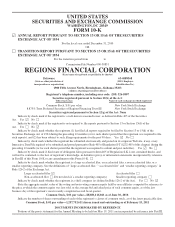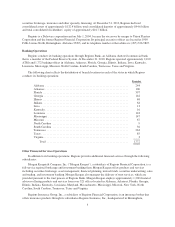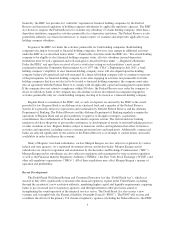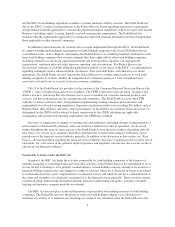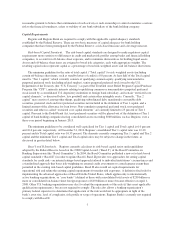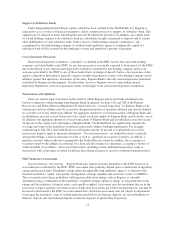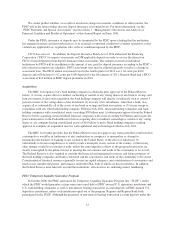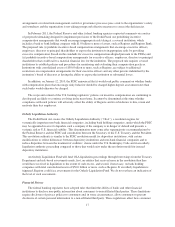Regions Bank 2010 Annual Report Download - page 21
Download and view the complete annual report
Please find page 21 of the 2010 Regions Bank annual report below. You can navigate through the pages in the report by either clicking on the pages listed below, or by using the keyword search tool below to find specific information within the annual report.reasonable grounds to believe that continuation of such activity or such ownership or control constitutes a serious
risk to the financial soundness, safety or stability of any bank subsidiary of the bank holding company.
Capital Requirements
Regions and Regions Bank are required to comply with the applicable capital adequacy standards
established by the Federal Reserve. There are two basic measures of capital adequacy for bank holding
companies that have been promulgated by the Federal Reserve: a risk-based measure and a leverage measure.
Risk-based Capital Standards. The risk-based capital standards are designed to make regulatory capital
requirements more sensitive to differences in credit and market risk profiles among banks and financial holding
companies, to account for off-balance sheet exposure, and to minimize disincentives for holding liquid assets.
Assets and off-balance sheet items are assigned to broad risk categories, each with appropriate weights. The
resulting capital ratios represent capital as a percentage of total risk-weighted assets and off-balance sheet items.
The minimum guideline for the ratio of total capital (“Total capital”) to risk-weighted assets (including
certain off-balance sheet items, such as standby letters of credit) is 8.0 percent. At least half of the Total capital
must be “Tier 1 capital,” which currently consists of qualifying common equity, qualifying noncumulative
perpetual preferred stock (including related surplus), senior perpetual preferred stock issued to the U.S.
Department of the Treasury (the “U.S. Treasury”) as part of the Troubled Asset Relief Program Capital Purchase
Program (the “CPP”), minority interests relating to qualifying common or noncumulative perpetual preferred
stock issued by a consolidated U.S. depository institution or foreign bank subsidiary, and certain “restricted core
capital elements,” as discussed below, less goodwill and certain other intangible assets. Currently, “Tier 2
capital” may consist of, among other things, qualifying subordinated debt, mandatorily convertible debt
securities, preferred stock and trust preferred securities not included in the definition of Tier 1 capital, and a
limited amount of the allowance for loan losses. Non-cumulative perpetual preferred stock, trust preferred
securities and other so-called “restricted core capital elements” are currently limited to 25 percent of Tier 1
capital. Pursuant to the Dodd-Frank Act, trust preferred securities will be phased-out of the definition of Tier 1
capital of bank holding companies having consolidated assets exceeding $500 million, such as Regions, over a
three-year period beginning in January 2013.
The minimum guideline to be considered well-capitalized for Tier 1 capital and Total capital is 6.0 percent
and 10.0 percent, respectively. At December 31, 2010, Regions’ consolidated Tier 1 capital ratio was 12.40
percent and its Total capital ratio was 16.35 percent. The elements currently comprising Tier 1 capital and Tier 2
capital and the minimum Tier 1 capital and Total capital ratios may be subject to change in the future, as
discussed in greater detail below.
Basel I and II Standards. Regions currently calculates its risk-based capital ratios under guidelines
adopted by the Federal Reserve based on the 1988 Capital Accord (“Basel I”) of the Basel Committee on
Banking Supervision (the “Basel Committee”). In 2004, the Basel Committee published a new set of risk-based
capital standards (“Basel II”) in order to update Basel I. Basel II provides two approaches for setting capital
standards for credit risk—an internal ratings-based approach tailored to individual institutions’ circumstances and
a standardized approach that bases risk-weighting on external credit assessments to a much greater extent than
permitted in the existing risk-based capital guidelines. Basel II also would set capital requirements for
operational risk and refine the existing capital requirements for market risk exposures. A definitive final rule for
implementing the advanced approaches of Basel II in the United States, which applies only to internationally
active banking organizations, or “core banks” (defined as those with consolidated total assets of $250 billion or
more or consolidated on-balance sheet foreign exposures of $10 billion or more) became effective on April 1,
2008. Other U.S. banking organizations may elect to adopt the requirements of this rule (if they meet applicable
qualification requirements), but are not required to comply. The rule also allows a banking organization’s
primary federal supervisor to determine that application of the rule would not be appropriate in light of the
bank’s asset size, level of complexity, risk profile or scope of operations. Regions Bank is currently not required
to comply with Basel II.
7


